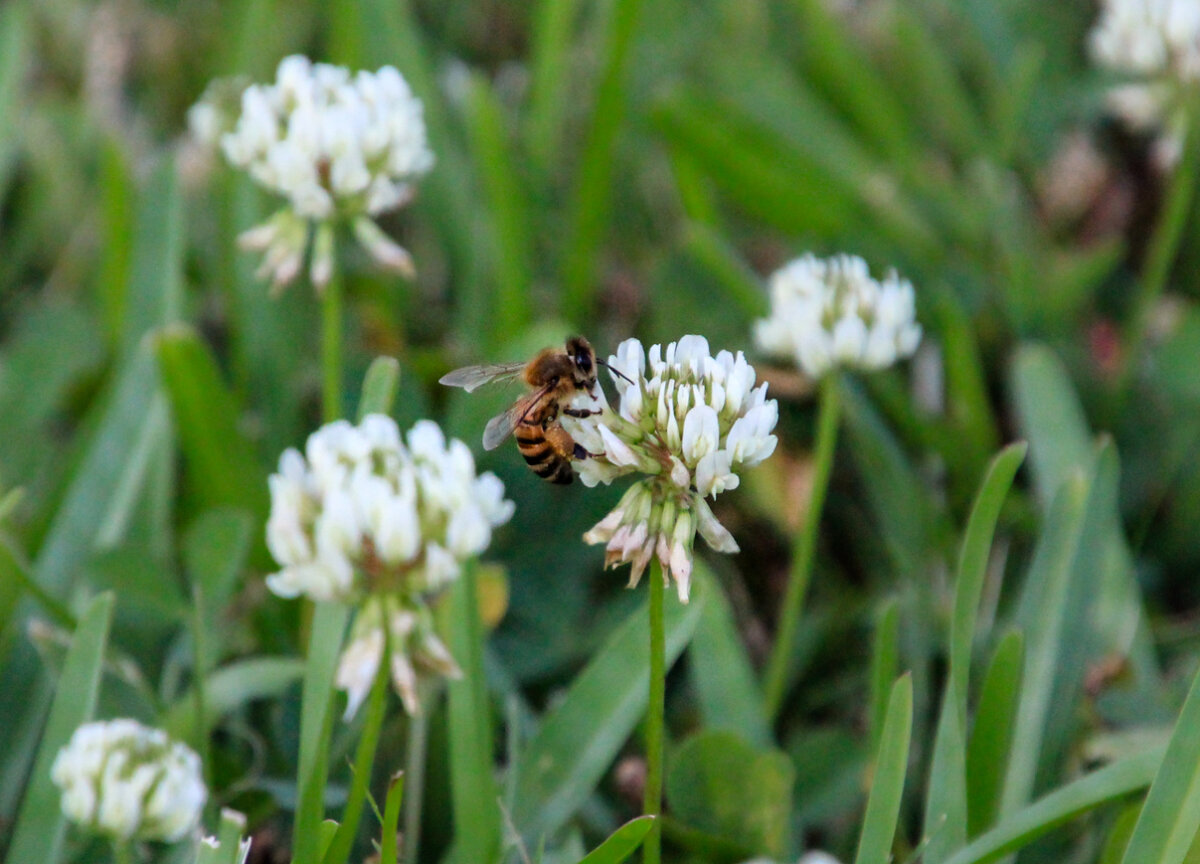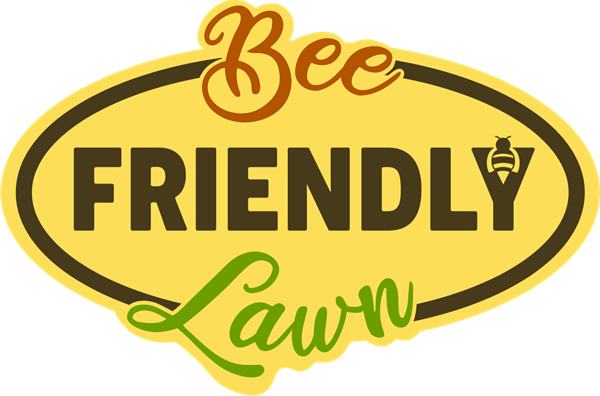
A Bee Friendly Lawn might include flowering plants like clover. Clover is a great source of nectar for bees, and it acts as a natural fertilizer. Clover used to be a standard component of all lawn seed mixes.
Would you like to help the earth in your own yard this Earth Day? Then change your lawn care practices. Growing a Bee Friendly Lawn will help our native bees, along with birds and other beneficial insects. And your lawn will look better, with less impact on the earth.
Traditional lawn care practices are heavily dependent on chemical inputs such as quick-release fertilizer and weed killers. With organic fertilizers, proper mowing, effective watering, and aeration and overseeding, you can grow a lawn that is thick and lush. A healthy lawn will naturally resist weeds, and it will look good with little or no herbicides.
Adopt good mowing practices
- Mow higher. Set your mower at about 2-1/2 to 3 inches. The higher grass will promote deeper roots, making the lawn more drought-tolerant. A higher lawn also shades the soil, which conserves moisture.
- Sharpen your mower blades. Dull blades tear the grass, providing ragged edges that allow diseases to enter.
- Mulch mow. This recycles nutrients, shades the soil and can suppress weed seeds.
- Read more in “How to mow for a Bee Friendly Lawn.”
- Note: We do not recommend participating in No Mow May. It may temporarily help pollinators, but won’t help the bees or your lawn in the long run.
Water slowly and deeply
- Water slowly and deeply, and less often. If you water a little every day, it encourages the lawn to grow shallow roots. If you water less often for a longer period of time, it encourages the grass to grow deeper roots, making it more drought-tolerant. How often to water depends on your soil. Sandy soil will need more frequent watering than clay soil.
- Water deeply from May to October. Aim for one to two inches of water per week.
- Don’t allow your lawn to go dormant in the summer. This will thin it out, and weeds and moss will move into thin and bare spots. It will also be more vulnerable to pests such as chafer beetles, which have increasingly been invading local lawns over the past several years. It is more environmentally friendly to water your lawn in the summer than to use herbicides and insecticides in the fall.
- Read more in “How to water for a Bee Friendly Lawn.”
 Allow some flowering plants
Allow some flowering plants
- Allow some flowering plants to grow in the lawn. Many bees and other helpful insects feed on clover. It is a great source of nectar. Clover also acts as a natural fertilizer. In fact, clover used to be a standard component of all lawn seed mixes. Dandelions play a crucial role in the health of bees and butterfly larvae.
- Mow clover and other flowering plants along with your grass. Remove dandelions with a hori hori knife or other weed-pulling tools.
- If you really want to use herbicides, spot spray problem plants, using the minimum amount.
- Don’t use weed-and-feed products. You would be spreading weed killers over your entire lawn just to kill a few unwanted plants.
- Read more in “Flowering plants help make a Bee Friendly Lawn.”
Use organic fertilizer regularly
- Organic, slow-release organic fertilizers feed your lawn slowly over time, helping it grow thick and strong. But fertilization won’t result in a robust, healthy lawn if you don’t mow and water properly.
- Don’t use quick-release chemical fertilizers. They provide a quick burst of nitrogen to the lawn. But the effect quickly fades, making your lawn dependent on drugs.
- Watch our video on how to fertilize your lawn.
Aerate and overseed annually
- Aeration has many benefits for your lawn. It reduces soil compaction. It helps lawn roots absorb air and water, it stimulates root growth, and more.
- Overseeding fills in thin and bare areas and thickens the lawn. This reduces competition from weeds and moss.
- Topdress as needed to fill in bare spots. It helps the lawn absorb water and nutrients, and it helps grass seeds to germinate successfully.
- Watch our video on aerating and top dressing.
Invest in some helpful tools
- An oscillating sprinkler will help you water the lawn deeply.
- An irrigation timer will help you apply the right amount of water.
- A soil probe allows you to measure how deeply the water has penetrated.
- A hori hori knife has a deep blade that gets more of the dandelion root, reducing the chance it will grow back.
- Read more in “Tools to help grow a Bee Friendly Lawn.”
Reduce the size of your lawn
- Replace the lawn in shady areas with plantings that will grow better in the shade. Lawns grow best where they get enough sunlight. They struggle to grow in areas that are shaded by trees or buildings.
- Consider other ways you would like to use your landscape. You might get more enjoyment by turning part of the lawn into a vegetable garden. Or perhaps you could add a patio for relaxation and entertaining. You might appreciate a water feature or walkway.
- Consider maintenance and aesthetics. Once established, trees, shrubs and other plantings require less maintenance than a lawn. They also provide more seasonal interest, with colors, shapes and aromas that may change through the seasons.
- Read more about downsizing your lawn in “A Bee Friendly Lawn may be smaller.”
We can help your lawn become Bee Friendly
In Harmony’s natural lawn care services help keep lawns healthy by feeding them with organic fertilizers, micronutrients and other natural products. We also offer aeration and overseeding.
We launched Bee Friendly Lawn to encourage our clients and others to maintain lawn health to protect bees and other beneficial creatures. We work in partnership with our clients to keep lawns healthy.
We will not use weed and moss killer on lawns that are not maintained properly. Integrated Pest Management guidelines say that pesticides should not be used without proper watering and mowing practices.
